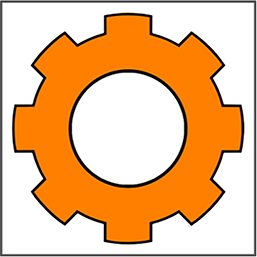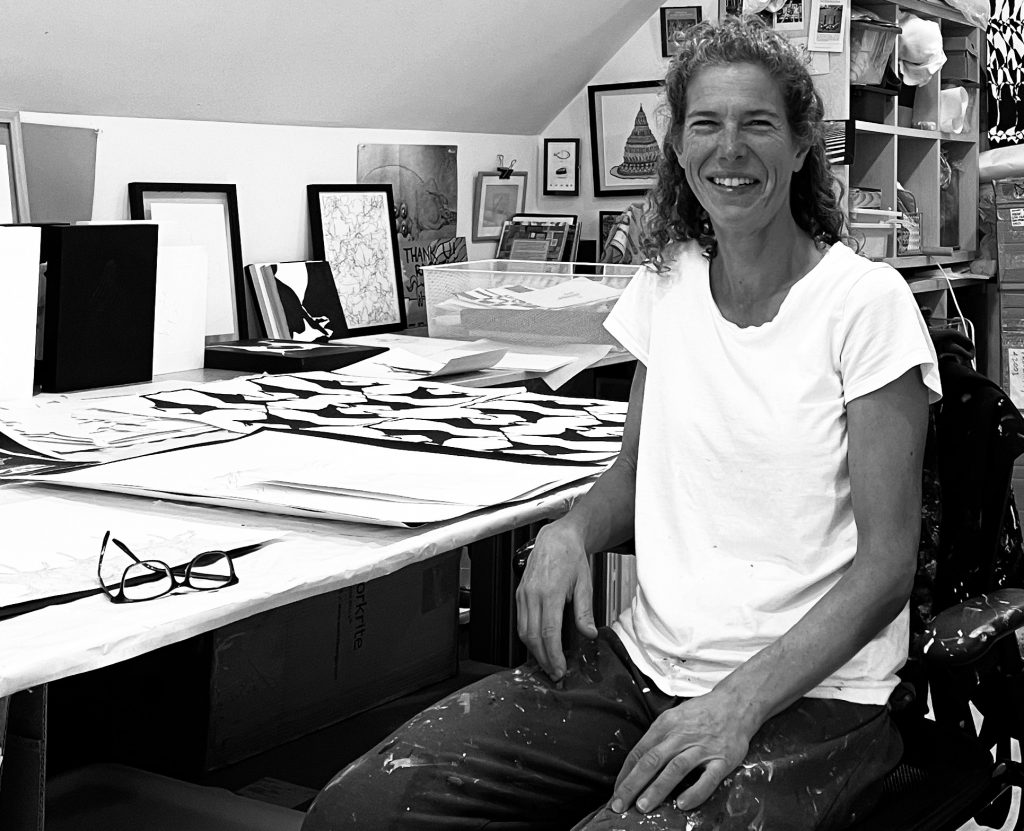
I arrived to Rachel Major’s San Francisco home and studio to a glorious spread of homemade bread, cheese and afternoon espresso. As I perked up from my after-teaching-day lull, I absorbed the visual spectacle of a home and work space brimming with creative hunger. Up until now, I have mostly seen Major’s work one or two pieces at a time in the gallery, but once inside her space I was invited into a wide-ranging studio practice that spans acrylic painting, works on paper and sculpture. Linking it all together is her deep inquiry into food and its role in our lives–particularly the historical connection of meat to manhood and cakes and desserts to womanhood in Western society.
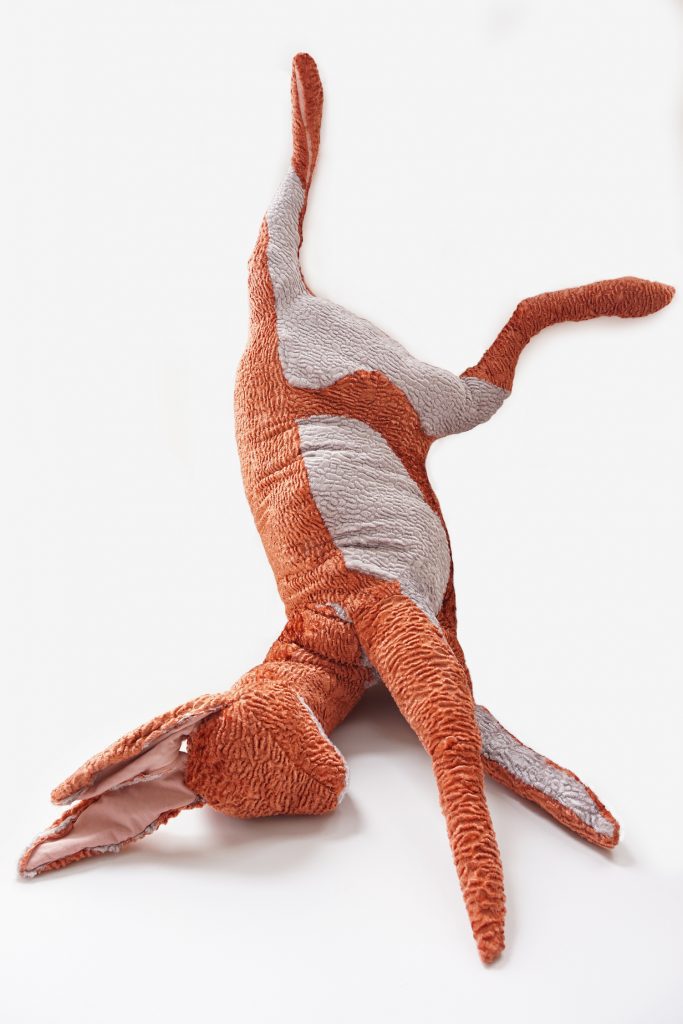
Fabric, polyester filling, thread, 69” x 30” x 10”
Major’s soft sculptures of animals have a tenderness and tactile comfort to them, even in their heartbreaking gesture. They seem to slouch and splay out as if just yanked from a pickup truck bed after the hunt. Some of the “Stuffed Meats” sculptures, at first glance, almost feel like functional pillows; plush and beautifully crafted. Not until reading the titles do we see which butcher-shop product do they reference.

Fabric, polyester filling, string, thread, 10” x 6” x 10”
The more recent work are Major’s acrylic paintings that are populated by clean-edged silhouettes of the butcher shop window. The stenciled animal silhouettes become part of a reflective motif that Major has explored in both monochrome and polychrome palettes. The black and white paintings have a shadow-like quality–as if we’re seeing the cast-shadow of hanging animal lit by multiple light sources.
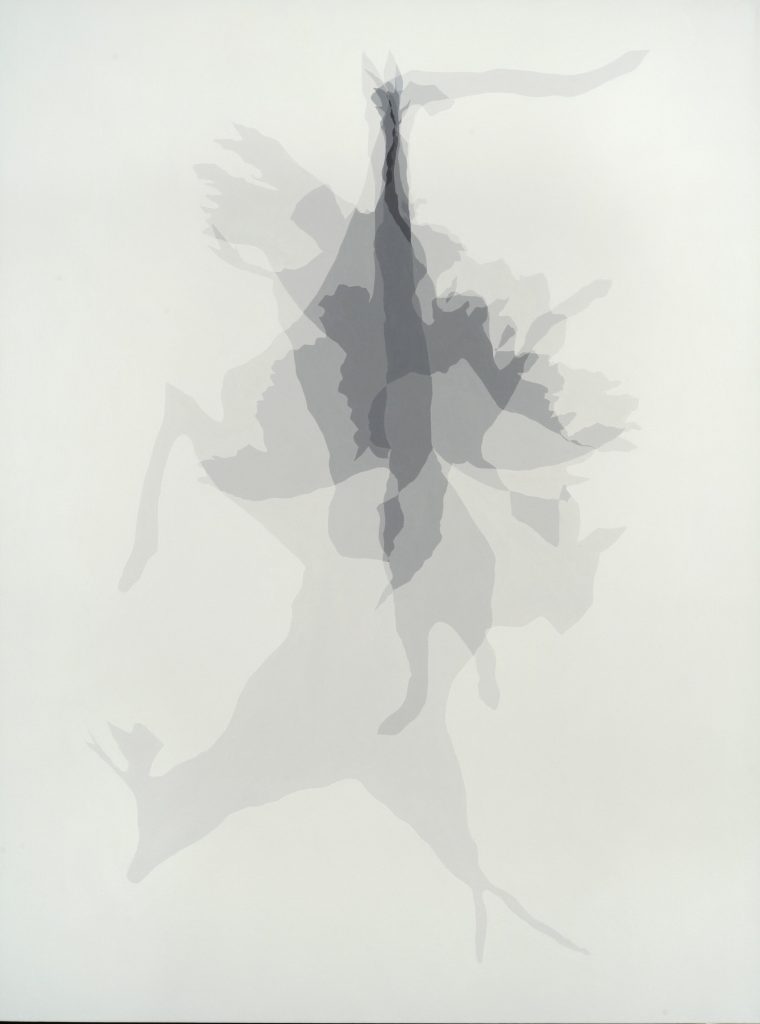
Acrylic on Canvas, 36” x 48”
The color silhouette paintings are a complex dialogue between flatly-painted colors that Major mixes on demand as the painting develops. Major described her painting process as beginning with a stenciled composition and then over several layers and studio sessions intuitively mixing and placing color in the stenciled shapes in a search for balance within the composition. The richly-hued shapes unfold across a horizontal axis in reference to the hanging carcasses in a butcher shop. Disrupting the sharply silhouetted-shapes Major allows the paint to drip to the bottom edge as if the animals are being drained of their technicolor blood.
The drips opened up another way of working and Major has started a new series (seen in the background of the studio photo below) that utilize the dripped line as the primary subject matter. In Major’s studio, I felt as if I was peering into not just a body of work being prepped for an exhibition, but also the inklings of side projects and alternate iterations on the central themes of still life, color-field painting and surface.
I remember thinking to myself, after our conversation; This is how you lead a life guided by art. The big questions serve as a guiding line for the courageous experiments with media and image. And when you have a show, you take away from the studio a few slices—but when the work leaves for the gallery, there’s always another enticing experiment to take its place on the easel.
Below is an excerpt of the many juicy morsels Rachel Major shared.
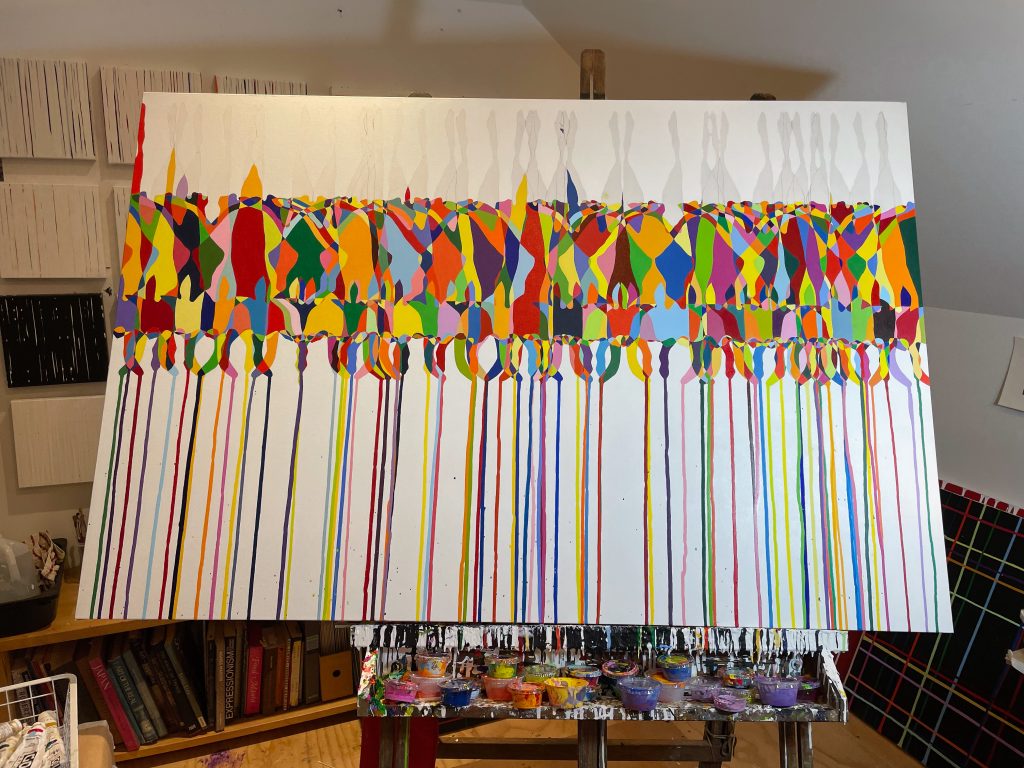
“The paintings are about being overwhelmed by color. I love putting colors together that usually shouldn’t go together…and creating an image without a single focal point.”
Rachel Major
How did your body of work for Reflections develop? How did you arrive at your exhibition’s theme?
I’ve been exploring the customs and rituals surrounding food and eating through my work for over 30 years and this body of work is another way to explore this subject matter. I’ve always been fascinated with displays of meat at markets and butcher shops- especially in Europe. Here we are less connected to our food source and prefer to see our meat nicely packaged so it doesn’t resemble an animal.
I first became interested in these displays during my third year of undergraduate school in Florence, Italy. I started taking pictures of meat in the markets and juxtaposing them with displays of mannequins. In these early pictures I was really thinking about the objectification of women, body image and ideas of beauty. As someone that struggled with an eating disorder I became fascinated with our cultures’ unhealthy relationship with food and eating and I began to explore the history of food and how it has transformed from purely sustenance into a culture of symbols and identity. To me, meat and to some extent sweets or cakes seem to embody these symbols.
It was interesting to come up with the theme. Despite our different mediums, I think Jane’s and my work are formally very similar. And even though our inspirations and subject matter are different, because the word ‘reflection’ has a lot of different meanings, it connects and describes both of our work.
How did you develop your silhouette still-life style? What does the reflected still-life represent?
I am drawn to the representations of the dead animals in Dutch still life paintings. Everything is right there in front of you, it’s so candid. I use those images of dead animals and create stencils. I overlap the stencils to almost obscure that it is an animal to create something almost abstract. Ideally the paintings look appealing and draw you in but at the same time the actual source or subject matter is uncomfortable. I love to play with that juxtaposition. The same is true for my fabric sculptures of meat. They are soft and cuddly but they are also pieces of meat.
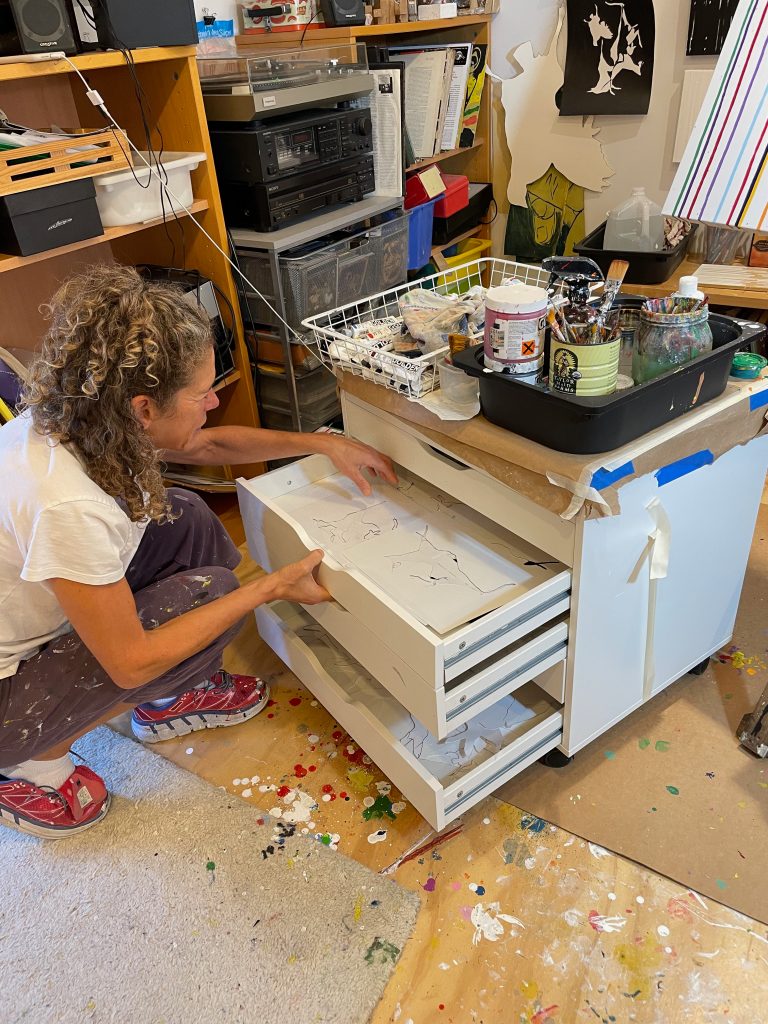
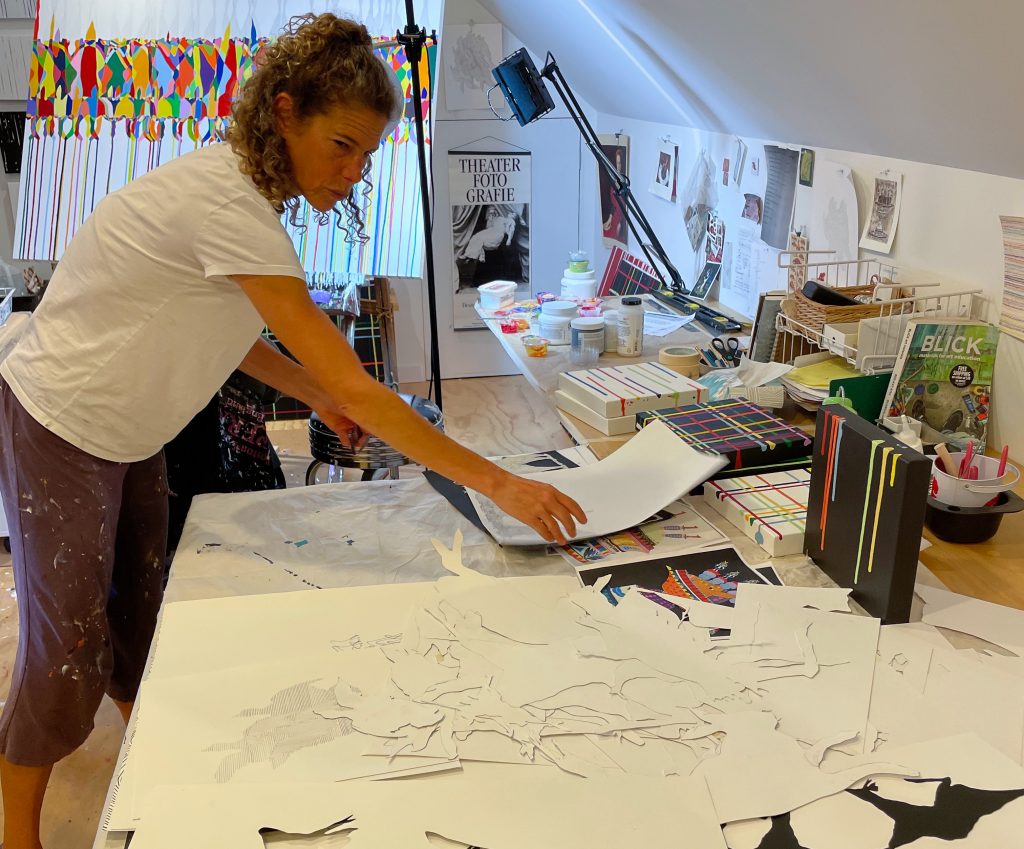
I’m fascinated by your description of meat as the embodiment of humanity’s control over animals. How did this realization develop for you? Why is it important for us to examine our relationship with animals?
I think part of what is so interesting to me is that this need to control nature is about creating order and having power and this mirrors the traditional roles of men and women. Strong women are a threat and our culture has found many ways to restrict and tamp down women. It is also interesting on a more individual level. How we need to control ourselves, our desires, our needs, our animal instincts. It is important to examine our relationship with animals because we are animals. How we treat animals reflects who we are.
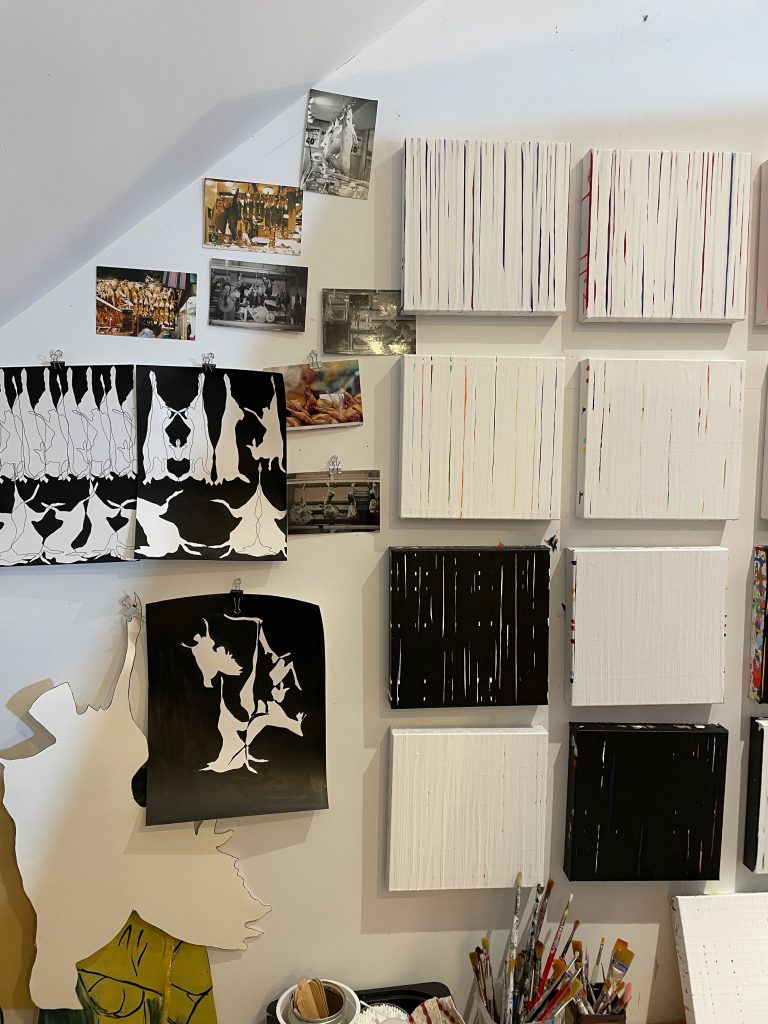
In Dewitt Cheng’s write-up for your show, he made a connection to the animal-rights content of Sue Coe. Is there a connection to animal rights in your work?
I am not an active animal rights activist but I do believe in the humane treatment of animals. There are so many reasons not to eat meat and really only one to eat meat— its taste( that’s not a bad thing). Whether or not that’s a good enough reason is up to the individual. That said, you don’t need to eat meat to survive but I also think that if you want to eat meat you can do it in a responsible way.
As an artist that works in both painting and sculpture, do the two ways of working develop in the studio simultaneously or are there times when you’re just focusing on the paintings or just the sculptures?
There have been times when I’m working on different mediums at the same time but eventually I get so drawn into one of them that I focus solely on that until I feel like I’ve gone as far as I can with whatever material I’m working with.
As a fellow art educator and practicing artist, how has teaching influenced your art-making?
Because I’m always looking for examples to show my students from a variety of artists, I have discovered so many new and interesting artists. I teach mostly elementary age students and try to focus on having them use their creative muscle, to make choices and that there is not one right answer. There are many ways to make art. It is a good reminder for me.
